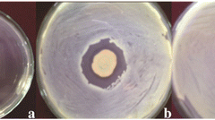Abstract
Comamonas testosteroni P15 and its mutant strain E23 can tolerate and utilize phenol as the sole source of carbon and energy at up to 15 mM and 20 mM, respectively. Compared to the wild type P15, mutant E23 showed higher values of K s and K i but a lower μmax value, and had lower phenol hydroxylase and catechol 2,3-dioxygenase activities. Without phenol exposure, mutant E23 demonstrated a two-fold greater amount of cardiolipin than the wild type P15. Upon exposure to phenol, an increase in cardiolipin at the expense of phosphatidylethanolamine was observed in the wild type P15. However, there was no significant difference in major phospholipid contents between mutant E23 cells grown in the presence or absence of phenol. It was noted that the ratio of trans/cis fatty acids of phosphatidylethanolamine and cardiolipin in mutant E23 was 65–70% higher than that in the wild type P15. In the absence of phenol, the degree of saturation of cardiolipin in mutant E23 was 33% higher than that in wild type P15. In contrast to earlier findings, an increase in C16:1 9trans with a simultaneous decrease in C18:1 11cis instead of C16:1 9cis was observed in specific classes of phospholipids.
Similar content being viewed by others
Author information
Authors and Affiliations
Additional information
Received: 30 July 1998 / Received last revision: 16 November 1998 / Accepted: 12 December 1998
Rights and permissions
About this article
Cite this article
Yap, L., Lee, Y. & Poh, C. Mechanism for phenol tolerance in phenol-degrading Comamonas testosteroni strain. Appl Microbiol Biotechnol 51, 833–840 (1999). https://doi.org/10.1007/s002530051470
Issue Date:
DOI: https://doi.org/10.1007/s002530051470




